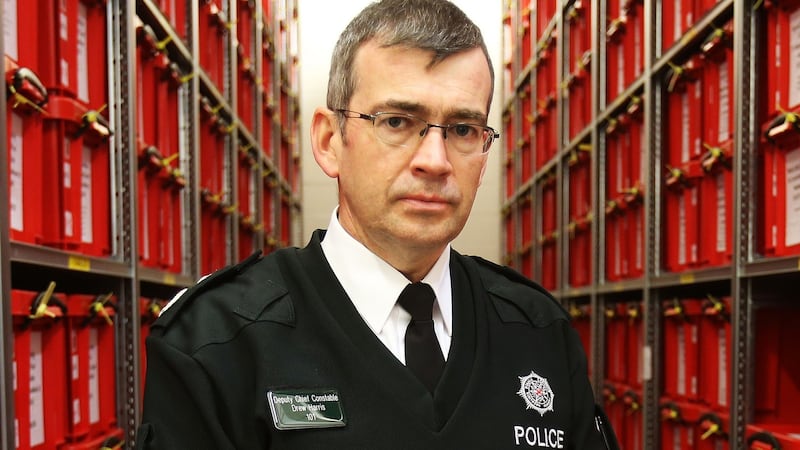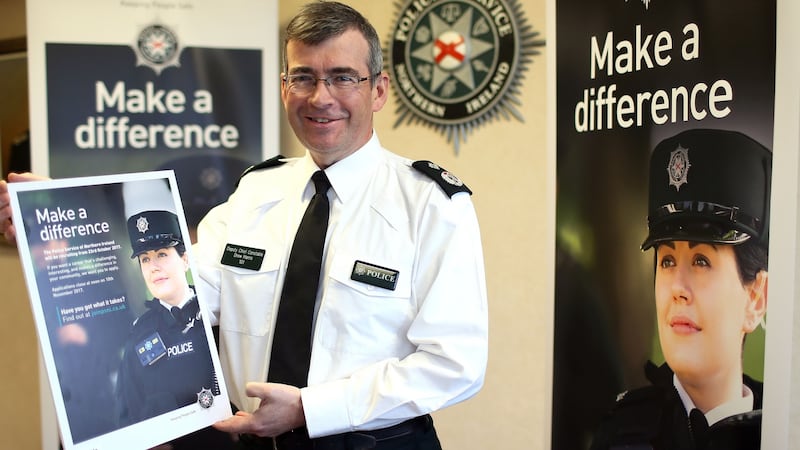Some troubles will just not go away. If Police Service of Northern Ireland deputy chief constable Drew Harris was hoping that when he stretches his legs under his desk in the Garda Commissioner’s office at the force’s Phoenix Park headquarters this September he could bid farewell to the Troubles he spent his professional life policing, then he may be in for a disappointment.
For the best part of a year, a team of detectives based in Ardee, Co Louth, has been re-investigating the July 1991 IRA murder of Tom Oliver, a sheep farmer from the Cooley Peninsula and father of seven, who was killed because of his alleged activities as an informer working for the Garda. What Harris knows and has said about the Tom Oliver murder – and the alleged involvement of a high-ranking Provisional activist – is central to their inquiry.
The murder was especially brutal. Oliver was badly beaten before being shot. A family member said of the killing: “Whoever they were, they thumped him and thumped him to get him to say what they wanted him to say. After the postmortem, a priest said it looked liked they’d dropped concrete blocks on every bone in his body.”
So, where does Drew Harris come into the story? Fast forward from the Oliver slaying to October 2012, to a closed hearing of the Smithwick tribunal which was investigating allegations of Garda complicity in the IRA murders of two senior RUC officers, Chief Supt Harry Breen and Supt Bob Buchanan after they had visited Dundalk Garda station in March 1989.
Claims had been made that individual gardaí had tipped off the IRA about the RUC officers’ trip. There were also allegations that the same gardaí, or one of them, had told the IRA about Tom Oliver.

Closed session
Drew Harris gave evidence to the tribunal in a closed session which the presiding judge, Peter Smithwick, later decided, after consultation with the northern authorities, to publish in a redacted form. The PSNI officer’s testimony was, he told Judge Smithwick, based on intelligence files compiled by the PSNI/RUC and the British security service, MI5.
Drew Harris gave evidence to the tribunal in a closed session which the presiding judge, Peter Smithwick, later decided to publish in a redacted form
The official record gives no indication of the response of those in the courtroom when Drew Harris came to speak of the Tom Oliver killing, but what he said about one intelligence file was nothing short of sensational. This was the exchange between the counsel for the tribunal and the presumptive Garda Commissioner:
“Q. Well, [file] Number 9 states: ‘Intelligence indicates that a senior PIRA Army Council member was directly involved in ordering the murder of Tom Oliver. The senior PIRA Army Council member had been approached by several PIRA members and others requesting that Tom Oliver not be killed. Despite these requests, the senior [PIRA Army Council] member directed that Oliver be executed.’ And do you know who that person was, and if so, have you passed on the information to the gardaí?
“A. I have, and that has been passed on in respect obviously of – the murder of Tom Oliver happened in this jurisdiction so it’s to aid to whatever inquiry An Garda Síochána is conducting into this matter.”
Asked if he would like to give the name of the Army Council member who sent Tom Oliver to his death, Harris opted to write it down and give it to Judge Peter Smithwick who promised that “. . . it would be retained securely”.
Harris’ contribution to the Smithwick tribunal was largely missed by the media. But one journalist picked up on it.

On her Prime Time RTÉ television show in March 2015, Miriam O’Callaghan said to then Sinn Féin president Gerry Adams: “There is a strong belief,” she said, “ . . . that you were [in] the court of appeal that said Tom Oliver should go to his death.”
Gerry Adams angrily protested his innocence: “How can you come on this programme and say that?” he asked. “I clearly deny it, it’s a very reprehensible accusation to make.”
That there is and has been a state of undeclared hostility between Drew Harris and Sinn Féin has been one of the salient features of post Belfast Agreement policing in the North.
Booby-trap bomb
If such a feeling characterises Harris’s stance, then it is easy to understand. His father, Alwyn Harris, a superintendent in the RUC, was killed in October 1989 by a booby-trap bomb attached to his car – a so-called “up and under” – as he and his wife were on their way to church from their home in Lisburn, Co Antrim.
His wife was not seriously injured but the policeman, who was on sick leave, died. Such booby-trap bombs invariably caused terrible injuries. The IRA admitted responsibility.
Mary Lou McDonald will have to shake Drew Harris's hand and look as if she is enjoying it – no matter what Gerry Adams thinks
Adams’s hostility on the other hand has its roots in the PSNI decision to arrest and hold him for four days in April 2014 for questioning about the “disappearance” of Jean McConville, who was abducted, killed and secretly buried by the IRA in 1972. Drew Harris reportedly signed off on Adams’s arrest.
He was also head of crime in the PSNI when authorisation was given to pursue interviews stored at Boston College’s oral history archive which led to Adams’s arrest. (In the interests of full disclosure: I was director of the archive.)
Later in 2014, Drew Harris sought promotion to PSNI deputy chief constable and Sinn Féin withdrew from the police authority selection panel. The northern media was briefed by Sinn Féin that anger at Adams’s arrest explained the protest.
Gerry Adams is no longer the leader of Sinn Féin. Mary Lou McDonald now heads the party and has been like a new broom, eagerly shaking the hand, for example, of visiting British royals and demonstrating a hitherto unthinkable readiness to share power with Fine Gael.
She will also have to shake Drew Harris’s hand and look as if she is enjoying it – no matter what Gerry Adams thinks.
None of this, however, will be of any consolation to Tom Oliver’s widow and his seven fatherless children.
Ed Moloney is author of A Secret History of the IRA and co-producer of I, Dolours









